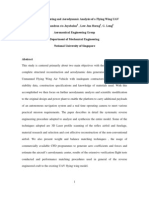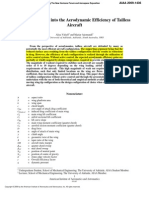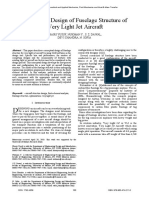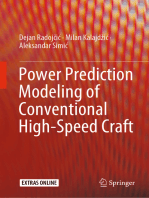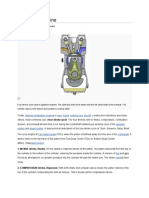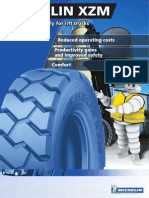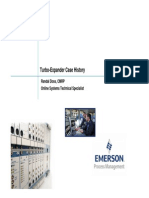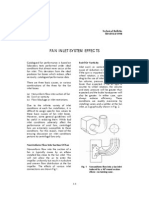Professional Documents
Culture Documents
Topology Optimization of Aircraft Wing Fuselage Lug Attachment Bracket
Copyright
Available Formats
Share this document
Did you find this document useful?
Is this content inappropriate?
Report this DocumentCopyright:
Available Formats
Topology Optimization of Aircraft Wing Fuselage Lug Attachment Bracket
Copyright:
Available Formats
Volume 7, Issue 3, March – 2022 International Journal of Innovative Science and Research Technology
ISSN No:-2456-2165
Topology Optimization of Aircraft Wing Fuselage
Lug Attachment Bracket
R S Harish, K Veda Abhishek, Harish U V, Tharundeep K G. Sakthivel, N Raghukiran
School of Mechanical Engineering Centre for Automation, School of Mechanical
Vellore Institute of Technology, EngineeringVellore Institute of Technology,
Chennai, India. Chennai, India.
Abstract:- Topology optimization has become an effective design [2,3]. The wings and the fuselage are the most integral
tool for light-weight and performance design, especially structural components of an aircraft. Wings are subjected to a
in the aeronautics and aerospace industry. It has proved spectrum of flight loads. During every flight, the airplane
to meet the requirement to produce intricate parts that takes off, flies to certain altitudes which pressurizes the
are more robust and lightweight. This technology has wings and the fuselage, and as a result metal fatigue is
proved costeffectiveness, improved payload capacity, and created. So in all the operable conditions, the wing and the
increased fuel economy in the aerospace sector, and fuselage must be rigidly attached together and in case of
enabled structural components to deliver the same or failure might lead to adverse accidents [4]. The lug is a part
enhanced performance while using less material. Among that connects the wing and the fuselage. Sometimes, the
the aircraft, the fuselage and the wings are important consequences of the failure of the lug can be very severe that
structural components. Wing fuselage lug attachment it might lead to the separation of the aircraft structure. Thus,
bracket is the connecting element that connects the wings it is important to establish damage-tolerant design criteria
and the fuselage. Catastrophic failure of the bracket may and analysis methods to ensure high performance and
sometimes lead to the separation of the aircraft structure. reliability of aircraft lug attachments [4,5,6]. To maintain the
This work is focused on modelling, shape optimization, load-carrying capacity and performance of the bracket, the
and analysis of an aircraft wing-fuselage lug attachment lug design must be optimized for a better strength to weight
bracket. The methodology involves modelling and shape ratio. A detailed study must be carried out on the load cases
optimization of the bracket using different sets of and the load to which the bracket is subjected must be
materials. Finite elemental modelling and structural calculated. Shape optimization must be performed on the
analysis were done to study the stresses and deformation structural domain of the lug according to the load path
on the bracket. Fatigue damage estimation is carried out criticality to achieve an optimal design. The structural
to study the behavior of bracket for repeated cyclic analysis must be carried out on the shape optimized bracket
loading. and comparison must be made between conventional design
and topology optimized design in aspects of the factor of
Keywords:- Topology optimization, wing-fuselage attachment safety (FOS) and deformation. Design decisions must be
bracket, fatigue damage, static structural, load factor, mass made without compromising on performance and load-
reduction. carrying capability to arrive at an optimal design. To validate
the design for repeated loading conditions, fatigue damage
I. INTRODUCTION estimation to crack initiation has to be carried out for a
An aircraft is a machine capable of flying by gaining typical flight load spectrum [6]. In this current work, an
support from the air. It has a complex structure comprising of attempt has been made to design and optimize the structure
basic components such as fuselage, wing, tail units, and of the wing-fuselage lug attachment bracket for a better
control system. Advancements in aircraft development have strength to weight ratio and estimate the fatigue damage
been rapid over the years. One of the active areas of factor for a typical flight load spectrum.
technological advancements is to meet the rising II. METHODOLOGY
environmental concerns dealing with pollution and global
warming due to aircraft emissions. This has led to various This paper is focused on 3D modelling and shape
research for alternative clean energy sources as well as to optimization of the bracket. Finite elemental modelling and
increase fuel efficiency [1]. Weight is one of the most structural analysis are done to study the stresses and
important factors affecting the efficiency of aircraft and flight deformation on the bracket. To understand the dynamic
endurance. Significant weight reduction can result in characteristics of the bracket under repeated cyclic loading
improvised efficiency, increased fuel economy thus and to validate the safety and reliability of the design, fatigue
increasing flight endurance. Reducing the mass of the aircraft damage estimation is done to calculate the life to crack
has proved to be an effective method in increasing the fuel initiation.
efficiency as lower mass requires lesser lift force and thrust
during flight [2]. Topology optimization has proved to be an
effective tool for mass reduction and performance design in
the aerospace industry. Topology optimization is an
algorithmic method of optimizing the distribution of material
within a specified structural domain according to the load
cases and boundary conditions to achieve the most efficient
IJISRT22MAR566 www.ijisrt.com 274
Volume 7, Issue 3, March – 2022 International Journal of Innovative Science and Research Technology
ISSN No:-2456-2165
Ultimate load = 169050×1.5 = 253575 N
Load distribution of on fuselage and wings = 25% and
75%.
Total load acting on the wings = 253575×0.75 =
190181.25 N
Load acting on each of the wings = 190181.25/2 =
95090.625 N
Number of spars in the wing = 3
Load should be shared by each of the spars:
i) spar 1 = 15% ii) spar 2 = 40% iii) spar 3 = 45%
For this analysis, spar 2 is chosen.
Therefore, load acting on it is = 95090.625×0.45 =
42790.78 N
Total load the bracket is subjected to, W = 42790.78 N
This load will induce the bending moment acting at the
Fig. 1: Workflow root of the bracket. Thus, it will act as a cantilever beam.
A. Geometric Parameterization and CAD Modelling Distance of the root of bracket from the lug node =
The wing-fuselage attachment bracket was modelled in 727.2 mm
Solidworks 2019 and the below figure shows the different
configurations of the model. Various structural components Bending moment created at the root of the bracket =
of the wing-fuselage lug attachment bracket are: 42790.78 N × 727.2 mm
Lug: A component with pin holes that connects the wing
with the fuselage. BM = 31108.89 Nm
I-spar: Integral part of wings which carries the weight of C. Material Specification
the wings and is subjected to flight loads. Wing surfacing is The material chosen for lug is heat-treated Steel alloy
done on the I-spar. AISI 4340 due to its high strength, toughness, and fatigue
Rivets: Permanent mechanical fasteners of the cylindrical strength [4,5,6]. For I-spar, the suitable material was decided
structure. as aluminum alloy 2024 T351 as it has an excellent strength-
to-weight ratio. It also has good machinability and surface
finish capability [4,5,6].
Sl. Parameters Steel Alloy Aluminium Alloy
No. AISI-4340 2024-T351
1 Young’s 203000 72400
Modulus (MPa)
2 Poisson’s ratio 0.32 0.33
3 Ultimate tensile 1835 483
strength (MPa)
4 Yield stress,σy 1550 345
(MPa)
Table 1: Material property table for chosen materials for lug
and I-spar.
D. Topology Optimization
Topology optimization is an algorithmic method of
Fig. 2: Geometric configuration of the wing fuselage lug
optimizing the distribution of material within a specified
attachment bracket
structural domain according to the load cases and boundary
B. Load Case Study and Calculations conditions to achieve the most efficient design [1,2,3].
Airplane type = medium size aircraft Topology optimization of the bracket was carried out in
Weight of Aircraft (MTOW) = 5750 kg = 56350 N Autodesk Fusion 360. The optimization process is as follows:
Load factor considered in design = 3g Initially, the shape optimization target needs to be set. In our
Limit load on the structure = 169050 N case, the lug part of the wingfuselage attachment bracket is
Factor of safety = 1.5 set as the optimization target. Under the material study
feature, respective materials for lug (steel alloy AISI 4340)
IJISRT22MAR566 www.ijisrt.com 275
Volume 7, Issue 3, March – 2022 International Journal of Innovative Science and Research Technology
ISSN No:-2456-2165
and I-spar (aluminum alloy 2024 T351) was applied. A
model-based size mesh is generated for the bracket with
26348 nodes and 105260 elements. Under optimization
settings, target mass is set as below or equal to 60% with
maximizing stiffness as the goal objective. The entire I-spar
region is set as a preserved region as we aim to optimize the
lug part of the bracket. And a 40 mm offset from both the lug
holes is set as a preserved region considering safety aspects.
The load case needs to be specified for the model. Both the
lug holes of the bracket are structurally constrained with all
six degrees of freedom. A vertical load of 42791 N is applied
at one end of the I-spar acting upwards which creates the
required bending moment. Contacts type is set as bonded Fig. 4: Finite elemental model of the bracket
contact.
III. RESULTS AND DISCUSSIONS
A. Static Structural Analysis Load and Boundary Conditions
The below figure shows the load and boundary conditions
applied on the topology optimized bracket. Both the nodes of
the lug section of the bracket are structurally constrained with
all six degrees of freedom. A vertical load of 42791 N is
applied at one end of the I-spar acting upwards (Y-direction)
which creates the required bending moment [6,8].
Fig. 3: Optimal topology design for the lug portion of the
bracket
A significant mass reduction of nearly 30% was
achieved. Mass of the lug was reduced from 27.99 kg to
19.64 kg after shape optimization. The above figure shows
the load path criticality of the lug for the applied load case.
Fig. 5: Load and boundary conditions applied on the bracket
Name Value B. Analysis Readings
Mass before 27.999 kg The maximum deformation was found to be 0.46 mm and
it occurred on the edge of the I-spar region. The below figure
Mass after 19.640 kg shows the total deformation contour of the bracket when
Mass Ratio 70.15% subjected to a bending load of 42791 N. The observed
Table 2: Topology Optimization Summary displacement (0.46 mm) lies within 1.3% of the total length
of the bracket. This is permissible according to the aircraft
E. Finite Elemental Modelling industry standards [5].
The finite element modelling (FEM) is a discretization
technique in structural mechanics. It uses a numerical method
to approximate the solution of boundary and/or initial value
problems characterized by partial differential equations
(PDEs) [7]. A finite elemental model of the topology
optimized bracket was carried out in ANSYS Workbench
19.0. Meshing is the process where the structural domain is
subdivided into smaller domains or elements known as
meshes. The entire structural domain was meshed with
tetrahedron type meshing. The fine mesh was accomplished
in high-stress gradient domains and the coarse mesh was
accomplished in low-stress gradient domains. As a result of
meshing 1666570 nodes and 826297 elements were
developed.
Fig. 6: Total deformation contour of the bracket
IJISRT22MAR566 www.ijisrt.com 276
Volume 7, Issue 3, March – 2022 International Journal of Innovative Science and Research Technology
ISSN No:-2456-2165
The maximum equivalent stress value was observed to D = ∑ (N𝑖/𝑁𝑓) = C
be 137 MPa occurring at the flange portion of the lug. The Where D = damage accumulate factor; Ni = applied
below figure shows the stress contour of the bracket when number of cycles; N𝑓 = number of cycles to failure; C =
subjected to a bending load of 42791 N. constant equal to 1.
Cycles Range of Stresses in lug portion
applied Load factor (MPa)
(Ni) g Minimum Maximum
stress stress
1000000 0.5g - 1.0g 20 73
712740 1.0g - 1.5g 30 109
156850 1.5g - 2.0g 39 145
69534 2.0g - 2.5g 49 181
35619 2.5g - 3.0g 60 218
Fig. 7: Stress contour of the bracket 20234 3.0g - 3.5g 70 254
12798 3.5g - 4.0g 80 290
The minimum factor of safety (FOS) for the optimal 8680 4.0g - 4.5g 90 326
topology design was found to be 1.82. Thus, we can conclude 4.5g - 5.0g
6268 100 363
that our design is safe.
4668 5.0g - 5.5g 109 399
3568 5.5g - 6.0g 120 435
Table 4: Stress values in the lug for flight load spectrum
The total damage accumulate (D) was calculated for
different load factors in the flight load spectrum and the total
damage accumulate factor is found to be 2.030959e-1 < 1.
According to Palmgren-Miner’s rule, the design is safe if the
damage accumulation factor happens to be less than unity
[6,10]. The result obtained is much lesser than unity and thus
we can validate that our design is safe and reliable. So, under
all the flight load spectrum the wing-fuselage lug attachment
bracket is safe and no crack initiation happens.
Fig. 8: The factor of safety [FOS] of the bracket Failure
Amplitude Mean Stress Damage
no.
stress stress ratio accumulate
C. COMPARISON BETWEEN CONVENTIONAL AND cycles
(MPa) (MPa) R D
TOPOLOGY OPTIMIZED DESIGN Nf
>10^7 26.50 46.50 0.27 0.1000000
Topology Optimized >10^7 39.50 69.50 0.28 0.0712740
Conventional Design
Design >10^7 53.00 92.00 0.27 0.0156850
Factor of Factor of >10^7 66.00 115.00 0.27 0.0069534
1.81 1.82
safety [FOS] safety [FOS] >10^7 79.00 139.00 0.28 0.0035619
Total Total >10^7 92.00 162.00 0.28 0.0020234
0.46 mm 0.46 mm
deformation deformation >10^7 105.00 185.00 0.28 0.0012798
Maximum Maximum >10^7 118.00 208.00 0.28 0.0008680
138 137
stress (MPa) stress (MPa) >10^7 131.50 231.50 0.28 0.0006268
Table 3: Design comparison >10^7 145.00 254.00 0.27 0.0004668
D. Fatigue Damage Estimation ∑D 0.2030959
From the results of static structural analysis of wing- Table 5: Fatigue damage accumulate factor under typical
fuselage lug attachment bracket, it is observed that the flight load spectrum
maximum stress occurs at the lug part whose material is steel
IV. CONCLUSION
AlSl 4340. Fatigue damage estimation of the bracket to crack
initiation was carried out in accordance with a typical flight Mass reduction is of major interest in improving aircraft
load spectrum [6,9]. A damage-tolerant design criterion and performance. In this work, we have designed and optimized
stress-life approach has been followed for carrying out the structure of the aircraft wing-fuselage bracket with
fatigue damage estimation [6,10]. Fatigue failure primarily topology optimization tools by studying the load paths and
occurs in three stages, i.e. crack initiation, crack propagation, validated the design by estimating the fatigue damage for
and final rupture. Calculation of fatigue life to crack repeated cyclic loading. A significant mass reduction in the
initiation is carried out by using Palmgren-Miner’s Rule. lug part of nearly 30% (27.99 kg to 19.64 kg) was achieved
According to Miner’s rule, by the topology optimization technique. Maximum
IJISRT22MAR566 www.ijisrt.com 277
Volume 7, Issue 3, March – 2022 International Journal of Innovative Science and Research Technology
ISSN No:-2456-2165
deformation of 0.46 mm, maximum equivalent stress of 137 [7.] Gokhale N. S. 2008. Practical finite element analysis.
MPa was observed and the minimum factor of safety of 1.82 Finite to infinite.
was achieved from the static structural analysis. From the [8.] Shambhu Kumar. 2017. Simulation of Wing-Fuselage
static structural analysis, the maximum stresses observed was Attachment Bracket Lug for Fighter Aircraft.
much lower than the yield strength, so the optimized bracket IJIMIINDS, 4(11), 68-73.
design is safe and reliable under all operable conditions
[9.] Rigby R. and Aliabadi M. H. 1997. Stress intensity
[5,6,12]. Fatigue damage estimation to crack initiation is
factors for cracks at attachment lugs. Engineering
carried out for the bracket. For the considered typical flight Failure Analysis, 4(2), 133-146.
load spectrum, the damage accumulate factor is much less
than unity, i.e. 0.2030959 < 1. So for all the load spectrum, [10.] Shashikumar C., Nagesh N., and Ganesh. 2016. Design
the design is safe and no crack initiation happens. and analysis of wing fuselage attachment bracket for
fighter aircraft. International Journal of Engineering
V. IMPLICATIONS AND INFLUENCES Research and General Science, 4(1), 79-91.
[11.] Handbook M. 1998. Metallic materials and elements for
Multi-body dynamic simulation of the bracket can be aerospace vehicle structures. Military Handbook No.
performed to study its behavior under dynamic conditions. MIL-HDBK-5H, Section, 5.
Fatigue crack growth analysis can be performed on the
[12.] Tarun Kumar B. Jain, Boopathi Raja G, and Meenakshi
bracket to calculate its life from crack initiation to the
Sundaram. 2016. Stress Analysis for Wing Attachment
fracture stage. Modal analysis can be performed on the
Brackets. IJERT, 4(5), 568-571.
bracket to study its performance under varied frequency
ranges. The use of composite material may result in
improvised strength to weight ratio. Structural testing of the
bracket can be carried to validate the theoretical calculation
and software analysis results.
ACKNOWLEDGMENT
We would like to extend our gratitude to Dassault
Systèmes and Autodesk for supporting and equipping us with
the educational licensed software.
REFERENCES
[1.] Zhu L., Li N., and Childs P. R. N. 2018. Light-
weighting in aerospace component and system design.
Propulsion and Power Research, 7(2), 103-119.
[2.] Ferro C. G., Mazza A., Belmonte D., Seclì C., and
Maggiore P. 2017. A comparison between 3D Printing
and Milling process for a Spar Cap Fitting (wing-
fuselage) of UAV Aircraft. Procedia CIRP, 62, 487-
493.
[3.] Bendsoe M. P. and Sigmund O. 2013. Topology
optimization: theory, methods, and applications.
Springer Science & Business Media.
[4.] Sriranga, B. K., and Kumar, R. 2014. Stress Analysis
and Fatigue Life Prediction of Wing-Fuselage Lug Joint
Attachment Bracket of a Transport Aircraft.
International Journal of Research in Engineering and
Technology, 3(3), 818-822.
[5.] Abraham Pulickal J. 2017. Design Structural Analysis
and Fatigue Calculation of Wing Fuselage Lug
Attachment of a Transport Aircraft. IJMETR, 4(8), 60-
65.
[6.] Sumanth M.H. and Ayyappa T. 2018. COMPARATIVE
ANALYSIS OF AIRCRAFT WING FUSELAGE LUG
ATTACHMENT BRACKET. IJTRE, 5(11), 4422-
4429.
IJISRT22MAR566 www.ijisrt.com 278
You might also like
- Optimization OF Aircraft Wing With Composite Material: ISSN: 2319-8753Document7 pagesOptimization OF Aircraft Wing With Composite Material: ISSN: 2319-8753Manoj BallaNo ratings yet
- GansDocument9 pagesGansganesh_the_aviatorNo ratings yet
- Reverse Engineering and Aerodynamic Analysis of A Flying Wing UAV ATSChandranDocument13 pagesReverse Engineering and Aerodynamic Analysis of A Flying Wing UAV ATSChandrancsulbstudent1No ratings yet
- Significant of Loading Performance On Sukhoi - 37Document7 pagesSignificant of Loading Performance On Sukhoi - 37Nambi RajanNo ratings yet
- Shankar 2021Document9 pagesShankar 2021João OtávioNo ratings yet
- Stress Analysis and Fatigue Life Prediction of Wing - Fuselage Lug Joint Attachment Bracket of A Transport AircraftDocument5 pagesStress Analysis and Fatigue Life Prediction of Wing - Fuselage Lug Joint Attachment Bracket of A Transport AircraftInternational Journal of Research in Engineering and TechnologyNo ratings yet
- Design and fly a flying wing under 40 charsDocument28 pagesDesign and fly a flying wing under 40 charsRutvik KarpeNo ratings yet
- 2018 1 X Y HamadaDocument28 pages2018 1 X Y HamadaGaurav Kumar ThakurNo ratings yet
- Winglet Multi-Objective Shape OptimizationDocument17 pagesWinglet Multi-Objective Shape OptimizationDerekNo ratings yet
- Weight Trades in The Design of A Composite Wing BoDocument15 pagesWeight Trades in The Design of A Composite Wing Boedoardo salviNo ratings yet
- Twist Morphing: A Simulation Approach To Compare Twist Morphed Wing and Flap ConfigurationDocument9 pagesTwist Morphing: A Simulation Approach To Compare Twist Morphed Wing and Flap ConfigurationIJRASETPublicationsNo ratings yet
- Aircraft Design Project II: Business Jet DesigningDocument54 pagesAircraft Design Project II: Business Jet Designingu2b11517No ratings yet
- Box-Wing Configurations - A Future ScenarioDocument2 pagesBox-Wing Configurations - A Future ScenarioBao NguyenNo ratings yet
- Design of Unmanned Aerial Combat VehicleDocument70 pagesDesign of Unmanned Aerial Combat Vehiclemurad_ashourNo ratings yet
- Optimization: of Joined-Wing AircraftDocument10 pagesOptimization: of Joined-Wing AircraftSagar KulkarniNo ratings yet
- Performance Analysis of High Wing For A Micro Class Unmanned Aerial VehicleDocument9 pagesPerformance Analysis of High Wing For A Micro Class Unmanned Aerial VehicleHimanshi GomberNo ratings yet
- DPPM REVIEW 3 FinalDocument17 pagesDPPM REVIEW 3 FinalTarun A.No ratings yet
- Tip Extensions, Winglets, and C-Wings: Conceptual Design and OptimizationDocument33 pagesTip Extensions, Winglets, and C-Wings: Conceptual Design and Optimizationfelo82No ratings yet
- Modeling and Analysis of Ribs and Spar of An Aeroplane Wing: Gadi Pradeep Reddy K.Ajaya Kumar ReddyDocument6 pagesModeling and Analysis of Ribs and Spar of An Aeroplane Wing: Gadi Pradeep Reddy K.Ajaya Kumar ReddyAmitejNo ratings yet
- Endurance GliderDocument16 pagesEndurance Gliderumunera2997No ratings yet
- Stress Analysis of Landing Gear of Light UnmannedDocument7 pagesStress Analysis of Landing Gear of Light Unmannedshayant nandiNo ratings yet
- Stress Analysis of Wing Fuselage Lug Attachment of A Transport A/cDocument8 pagesStress Analysis of Wing Fuselage Lug Attachment of A Transport A/cAbrahamJPulickalNo ratings yet
- An Investigation of The Aerodynamic Efficiency of Tailess AircraftDocument9 pagesAn Investigation of The Aerodynamic Efficiency of Tailess AircraftPaul Pipi OkonkwoNo ratings yet
- Chapter 16 - Morphing of The Leading Edge - 2018 - Morphing Wing TechnologiesDocument25 pagesChapter 16 - Morphing of The Leading Edge - 2018 - Morphing Wing TechnologiesRichardNo ratings yet
- Analysis of Helicopter Skid Landing Gear Made of Composite MaterialsDocument9 pagesAnalysis of Helicopter Skid Landing Gear Made of Composite MaterialsДмитрий ДмитренкоNo ratings yet
- Design of An Aircraft Wing Structure For Static Analysis and Fatigue LifeDocument5 pagesDesign of An Aircraft Wing Structure For Static Analysis and Fatigue Lifeankitsinghal54No ratings yet
- Com Sol Conference PaperDocument7 pagesCom Sol Conference PaperVandan ChinnappaNo ratings yet
- Experimental Investigation of A Bi-PlaneDocument9 pagesExperimental Investigation of A Bi-PlaneRafael TavaresNo ratings yet
- Selecting Principal Parameters of Baseline Design Configuration For Light General Aviation AircraftDocument11 pagesSelecting Principal Parameters of Baseline Design Configuration For Light General Aviation AircraftIbrahim KNo ratings yet
- Conceptual Design of Fuselage StructureDocument7 pagesConceptual Design of Fuselage StructurefiemsabyasachiNo ratings yet
- Design and Analysis of Wing Fuselage AttachmentDocument6 pagesDesign and Analysis of Wing Fuselage AttachmentAbrahamJPulickalNo ratings yet
- Modeling and CFD Analysis of Flow Over Aircraft Split Winglet and Blended WingletDocument6 pagesModeling and CFD Analysis of Flow Over Aircraft Split Winglet and Blended WingletArif AdjaNo ratings yet
- Race Car Front Wing DesignDocument12 pagesRace Car Front Wing DesignalikulekcimNo ratings yet
- Aerodynamic Analysis of Variable Cant Angle Winglets For Improved Aircraft PerformanceDocument7 pagesAerodynamic Analysis of Variable Cant Angle Winglets For Improved Aircraft Performancelado prakasaNo ratings yet
- NCAS2015 Bucharest Romania 5-6 11 2015 Velkova Todorov-1Document5 pagesNCAS2015 Bucharest Romania 5-6 11 2015 Velkova Todorov-1Alejandro Sergio FerenzNo ratings yet
- A Study On Conceptual Structural Design of Fuselage For A Small Scale Wig Vehicle Using Composite MaterialsDocument8 pagesA Study On Conceptual Structural Design of Fuselage For A Small Scale Wig Vehicle Using Composite Materialskats2404No ratings yet
- Ask 21 Flight SimDocument33 pagesAsk 21 Flight Simsovsep100% (1)
- Preliminary Design of A Structural Wing Box Under A Twist Constraint Part IDocument10 pagesPreliminary Design of A Structural Wing Box Under A Twist Constraint Part ITrenton EnglishNo ratings yet
- Computational Analysis and Optimization of Boxwing Aircraft For Reducing Induced DragDocument7 pagesComputational Analysis and Optimization of Boxwing Aircraft For Reducing Induced Dragamir7980No ratings yet
- Propeller Design Conf V1Document17 pagesPropeller Design Conf V1Fan SMGNo ratings yet
- Aerodynamic Analysis of Dimple Effect On Aircraft WingDocument4 pagesAerodynamic Analysis of Dimple Effect On Aircraft WingMoses DevaprasannaNo ratings yet
- Finite Element Analysis of Composite Aircraft Fuselage FrameDocument8 pagesFinite Element Analysis of Composite Aircraft Fuselage FrameIRJMETS JOURNALNo ratings yet
- Report 3D Finite Element Model of DLR-F6 Aircraft WingDocument68 pagesReport 3D Finite Element Model of DLR-F6 Aircraft WingjohnkevinmdizonNo ratings yet
- Conceptual Design of Fuselage StructureDocument7 pagesConceptual Design of Fuselage StructuredharmonNo ratings yet
- COMPOSITE WING OPTIMALIZATION USING FEM ANALYSES SYSTEMS by Miroslav Spišák - Peter MalatinDocument3 pagesCOMPOSITE WING OPTIMALIZATION USING FEM ANALYSES SYSTEMS by Miroslav Spišák - Peter MalatinVesa RäisänenNo ratings yet
- Design, Static Structural and Modal Analysis of Aircraft Wing (Naca 4412) Using Anasys Workbench 14.5Document11 pagesDesign, Static Structural and Modal Analysis of Aircraft Wing (Naca 4412) Using Anasys Workbench 14.5Deepika PandeyNo ratings yet
- Multidisciplinary Airframe Design Process: Incorporation of Steady and Unsteady Aeroelastic LoadsDocument15 pagesMultidisciplinary Airframe Design Process: Incorporation of Steady and Unsteady Aeroelastic LoadsFernass DaoudNo ratings yet
- Fuselage Design For Stress Caused Due To Wing at Various Load ConditionsDocument48 pagesFuselage Design For Stress Caused Due To Wing at Various Load ConditionsSri Tech Engineering100% (1)
- 13th International Conference on Heat Transfer, Fluid Mechanics and Thermodynamics AerodynamicsDocument6 pages13th International Conference on Heat Transfer, Fluid Mechanics and Thermodynamics AerodynamicsLeo LonardelliNo ratings yet
- Extended AbstractDocument10 pagesExtended Abstractsabarish sabariNo ratings yet
- Design of 300 Ton Payload Cargo AircraftDocument54 pagesDesign of 300 Ton Payload Cargo AircraftSêlvâkûmâr JayabalaNo ratings yet
- Analysis of The Impact of Trailing-Edge Wing FlapsDocument10 pagesAnalysis of The Impact of Trailing-Edge Wing FlapsNL NapsNo ratings yet
- Shetty 2017Document7 pagesShetty 2017vaveyNo ratings yet
- Nonplanar Wing Concepts For Increased Aircraft EfficiencyDocument29 pagesNonplanar Wing Concepts For Increased Aircraft EfficiencyTudor VladNo ratings yet
- An Integrated Approach To The Preliminary Weight Sizing of Small Electric AircraftDocument37 pagesAn Integrated Approach To The Preliminary Weight Sizing of Small Electric Aircraftfeceric528No ratings yet
- Aeroelastic Design Code (Aedc) For High Aspect Ratio Wing SizingDocument10 pagesAeroelastic Design Code (Aedc) For High Aspect Ratio Wing SizingFurqanNo ratings yet
- Multidisciplinary Design Optimization of A UAV Wing Using KrigingDocument18 pagesMultidisciplinary Design Optimization of A UAV Wing Using KrigingŘøm ËõNo ratings yet
- Nielson Fin PlantformsDocument13 pagesNielson Fin PlantformsAsh WingNo ratings yet
- Fatigue Analysis For Typical AircraftDocument10 pagesFatigue Analysis For Typical AircraftSonu KumarNo ratings yet
- Automatic Power Factor ControllerDocument4 pagesAutomatic Power Factor ControllerInternational Journal of Innovative Science and Research TechnologyNo ratings yet
- Intelligent Engines: Revolutionizing Manufacturing and Supply Chains with AIDocument14 pagesIntelligent Engines: Revolutionizing Manufacturing and Supply Chains with AIInternational Journal of Innovative Science and Research TechnologyNo ratings yet
- Navigating Digitalization: AHP Insights for SMEs' Strategic TransformationDocument11 pagesNavigating Digitalization: AHP Insights for SMEs' Strategic TransformationInternational Journal of Innovative Science and Research TechnologyNo ratings yet
- A Review: Pink Eye Outbreak in IndiaDocument3 pagesA Review: Pink Eye Outbreak in IndiaInternational Journal of Innovative Science and Research TechnologyNo ratings yet
- Teachers' Perceptions about Distributed Leadership Practices in South Asia: A Case Study on Academic Activities in Government Colleges of BangladeshDocument7 pagesTeachers' Perceptions about Distributed Leadership Practices in South Asia: A Case Study on Academic Activities in Government Colleges of BangladeshInternational Journal of Innovative Science and Research TechnologyNo ratings yet
- Securing Document Exchange with Blockchain Technology: A New Paradigm for Information SharingDocument4 pagesSecuring Document Exchange with Blockchain Technology: A New Paradigm for Information SharingInternational Journal of Innovative Science and Research TechnologyNo ratings yet
- Mobile Distractions among Adolescents: Impact on Learning in the Aftermath of COVID-19 in IndiaDocument2 pagesMobile Distractions among Adolescents: Impact on Learning in the Aftermath of COVID-19 in IndiaInternational Journal of Innovative Science and Research TechnologyNo ratings yet
- Studying the Situation and Proposing Some Basic Solutions to Improve Psychological Harmony Between Managerial Staff and Students of Medical Universities in Hanoi AreaDocument5 pagesStudying the Situation and Proposing Some Basic Solutions to Improve Psychological Harmony Between Managerial Staff and Students of Medical Universities in Hanoi AreaInternational Journal of Innovative Science and Research TechnologyNo ratings yet
- Review of Biomechanics in Footwear Design and Development: An Exploration of Key Concepts and InnovationsDocument5 pagesReview of Biomechanics in Footwear Design and Development: An Exploration of Key Concepts and InnovationsInternational Journal of Innovative Science and Research TechnologyNo ratings yet
- Perceived Impact of Active Pedagogy in Medical Students' Learning at the Faculty of Medicine and Pharmacy of CasablancaDocument5 pagesPerceived Impact of Active Pedagogy in Medical Students' Learning at the Faculty of Medicine and Pharmacy of CasablancaInternational Journal of Innovative Science and Research TechnologyNo ratings yet
- Formation of New Technology in Automated Highway System in Peripheral HighwayDocument6 pagesFormation of New Technology in Automated Highway System in Peripheral HighwayInternational Journal of Innovative Science and Research TechnologyNo ratings yet
- Natural Peel-Off Mask Formulation and EvaluationDocument6 pagesNatural Peel-Off Mask Formulation and EvaluationInternational Journal of Innovative Science and Research TechnologyNo ratings yet
- Drug Dosage Control System Using Reinforcement LearningDocument8 pagesDrug Dosage Control System Using Reinforcement LearningInternational Journal of Innovative Science and Research TechnologyNo ratings yet
- The Effect of Time Variables as Predictors of Senior Secondary School Students' Mathematical Performance Department of Mathematics Education Freetown PolytechnicDocument7 pagesThe Effect of Time Variables as Predictors of Senior Secondary School Students' Mathematical Performance Department of Mathematics Education Freetown PolytechnicInternational Journal of Innovative Science and Research TechnologyNo ratings yet
- Enhancing the Strength of Concrete by Using Human Hairs as a FiberDocument3 pagesEnhancing the Strength of Concrete by Using Human Hairs as a FiberInternational Journal of Innovative Science and Research TechnologyNo ratings yet
- Supply Chain 5.0: A Comprehensive Literature Review on Implications, Applications and ChallengesDocument11 pagesSupply Chain 5.0: A Comprehensive Literature Review on Implications, Applications and ChallengesInternational Journal of Innovative Science and Research TechnologyNo ratings yet
- Advancing Opthalmic Diagnostics: U-Net for Retinal Blood Vessel SegmentationDocument8 pagesAdvancing Opthalmic Diagnostics: U-Net for Retinal Blood Vessel SegmentationInternational Journal of Innovative Science and Research TechnologyNo ratings yet
- The Making of Self-Disposing Contactless Motion-Activated Trash Bin Using Ultrasonic SensorsDocument7 pagesThe Making of Self-Disposing Contactless Motion-Activated Trash Bin Using Ultrasonic SensorsInternational Journal of Innovative Science and Research TechnologyNo ratings yet
- Placement Application for Department of Commerce with Computer Applications (Navigator)Document7 pagesPlacement Application for Department of Commerce with Computer Applications (Navigator)International Journal of Innovative Science and Research TechnologyNo ratings yet
- REDLINE– An Application on Blood ManagementDocument5 pagesREDLINE– An Application on Blood ManagementInternational Journal of Innovative Science and Research TechnologyNo ratings yet
- Beyond Shelters: A Gendered Approach to Disaster Preparedness and Resilience in Urban CentersDocument6 pagesBeyond Shelters: A Gendered Approach to Disaster Preparedness and Resilience in Urban CentersInternational Journal of Innovative Science and Research TechnologyNo ratings yet
- Exploring the Clinical Characteristics, Chromosomal Analysis, and Emotional and Social Considerations in Parents of Children with Down SyndromeDocument8 pagesExploring the Clinical Characteristics, Chromosomal Analysis, and Emotional and Social Considerations in Parents of Children with Down SyndromeInternational Journal of Innovative Science and Research TechnologyNo ratings yet
- Handling Disruptive Behaviors of Students in San Jose National High SchoolDocument5 pagesHandling Disruptive Behaviors of Students in San Jose National High SchoolInternational Journal of Innovative Science and Research TechnologyNo ratings yet
- Safety, Analgesic, and Anti-Inflammatory Effects of Aqueous and Methanolic Leaf Extracts of Hypericum revolutum subsp. kenienseDocument11 pagesSafety, Analgesic, and Anti-Inflammatory Effects of Aqueous and Methanolic Leaf Extracts of Hypericum revolutum subsp. kenienseInternational Journal of Innovative Science and Research TechnologyNo ratings yet
- A Curious Case of QuadriplegiaDocument4 pagesA Curious Case of QuadriplegiaInternational Journal of Innovative Science and Research TechnologyNo ratings yet
- A Knowledg Graph Model for e-GovernmentDocument5 pagesA Knowledg Graph Model for e-GovernmentInternational Journal of Innovative Science and Research TechnologyNo ratings yet
- Analysis of Financial Ratios that Relate to Market Value of Listed Companies that have Announced the Results of their Sustainable Stock Assessment, SET ESG Ratings 2023Document10 pagesAnalysis of Financial Ratios that Relate to Market Value of Listed Companies that have Announced the Results of their Sustainable Stock Assessment, SET ESG Ratings 2023International Journal of Innovative Science and Research TechnologyNo ratings yet
- Pdf to Voice by Using Deep LearningDocument5 pagesPdf to Voice by Using Deep LearningInternational Journal of Innovative Science and Research TechnologyNo ratings yet
- Adoption of International Public Sector Accounting Standards and Quality of Financial Reporting in National Government Agricultural Sector Entities, KenyaDocument12 pagesAdoption of International Public Sector Accounting Standards and Quality of Financial Reporting in National Government Agricultural Sector Entities, KenyaInternational Journal of Innovative Science and Research TechnologyNo ratings yet
- Fruit of the Pomegranate (Punica granatum) Plant: Nutrients, Phytochemical Composition and Antioxidant Activity of Fresh and Dried FruitsDocument6 pagesFruit of the Pomegranate (Punica granatum) Plant: Nutrients, Phytochemical Composition and Antioxidant Activity of Fresh and Dried FruitsInternational Journal of Innovative Science and Research TechnologyNo ratings yet
- Updated Resume 2016Document4 pagesUpdated Resume 2016Ralph ManuelNo ratings yet
- ROV Brochure EnglishDocument8 pagesROV Brochure EnglishMuhammad Hayeri100% (1)
- fastener_handoutDocument32 pagesfastener_handoutamolhwNo ratings yet
- Aircraft Accident Report and Executive SummaryDocument10 pagesAircraft Accident Report and Executive SummaryakeelNo ratings yet
- Ata 71 A 80 Power Plant Iaev 2500Document310 pagesAta 71 A 80 Power Plant Iaev 2500juanNo ratings yet
- University Rover Challenge Rules 2017Document10 pagesUniversity Rover Challenge Rules 2017Soumyajyoti MukherjeeNo ratings yet
- STC SA00343BO - August 2022Document4 pagesSTC SA00343BO - August 2022EjamesNo ratings yet
- E IM 126 - PW210 TCDS Issue 03 - 0-1 PDFDocument8 pagesE IM 126 - PW210 TCDS Issue 03 - 0-1 PDFValBMSNo ratings yet
- Historical Failures and The Evolution of Fracture Mechanics - LinkedIn PDFDocument10 pagesHistorical Failures and The Evolution of Fracture Mechanics - LinkedIn PDFmargi gajjarNo ratings yet
- High Temperature CorrosionDocument3 pagesHigh Temperature CorrosiontechzonesNo ratings yet
- Raf RulesDocument25 pagesRaf RuleszyxNo ratings yet
- Introduction to Structural Analysis of Pneumatically Actuated PDMS FingersDocument10 pagesIntroduction to Structural Analysis of Pneumatically Actuated PDMS FingersNauman KhanNo ratings yet
- Project Pulse Jet EngineDocument18 pagesProject Pulse Jet EngineJoel Kevin SaldanhaNo ratings yet
- Rahul Lohar: Aeronautical EngineerDocument6 pagesRahul Lohar: Aeronautical EngineerRahul LoharNo ratings yet
- Numerical Investigation of Shock/Vortex Interaction in Hypersonic Thermochemical Nonequilibrium FlowDocument1 pageNumerical Investigation of Shock/Vortex Interaction in Hypersonic Thermochemical Nonequilibrium FlowKumbamNo ratings yet
- JT8D-1: Pratt & Whitney's turbofan for the Boeing 727Document1 pageJT8D-1: Pratt & Whitney's turbofan for the Boeing 727StrawichDanielNo ratings yet
- A Short IntroductionDocument4 pagesA Short IntroductionMURALINo ratings yet
- Flow CoefficientDocument1 pageFlow Coefficienthml2827No ratings yet
- Torsion Test Discussion by ShanDocument4 pagesTorsion Test Discussion by Shanshangovinna_1078109050% (8)
- Water Flying Sep Oct 2015 PDFDocument25 pagesWater Flying Sep Oct 2015 PDFLeon LellaNo ratings yet
- QW484Document1 pageQW484Anonymous 4e7GNjzGWNo ratings yet
- Four-stroke engine basicsDocument8 pagesFour-stroke engine basicsVamsidhar ReddyNo ratings yet
- 70-Power Plant (CFM56)Document326 pages70-Power Plant (CFM56)Anonymous QRVqOsa5No ratings yet
- 050663X XZM Indus GB (11-01)Document4 pages050663X XZM Indus GB (11-01)Felipe Morales AliagaNo ratings yet
- Flow SeparationDocument14 pagesFlow SeparationShyam PandeyNo ratings yet
- Glauert, H. - The Use of Small Wind Tunnels in Aeroplane Design (1931) (10.1017 - s0368393100115809) - Libgen - LiDocument24 pagesGlauert, H. - The Use of Small Wind Tunnels in Aeroplane Design (1931) (10.1017 - s0368393100115809) - Libgen - LiMariela TisseraNo ratings yet
- 6 Turbo-Expander Case History - EmersonDocument11 pages6 Turbo-Expander Case History - EmersonxinghustNo ratings yet
- 400scale - A330 Mrtt-GreyDocument1 page400scale - A330 Mrtt-GreyMohamed DhiaaNo ratings yet
- ODE Capability List 2017 10 24Document8 pagesODE Capability List 2017 10 24cesarNo ratings yet
- Fan Inlet System EffectsDocument4 pagesFan Inlet System EffectsEzrizal Yusuf100% (1)


